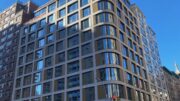Governor Kathy Hochul and New York City Mayor Eric Adams have unveiled the master plan for the Science Park and Research Campus (SPARC) Kips Bay, a new life sciences hub located on Hunter College’s Brookdale Campus at East 25th Street and First Avenue in Kips Bay. Designed to transform a full city block, SPARC Kips Bay is expected to create over 15,000 jobs and generate an economic impact of $42 billion over 30 years.
The campus will host state-of-the-art facilities for institutions like the Hunter College School of Nursing and the City University of New York (CUNY) Graduate School of Public Health, with up to 2 million square feet dedicated to academic, public health, and life sciences facilities. A key aspect of the project is its focus on workforce and educational opportunities, offering extensive programs to connect local public school students to careers in life sciences and healthcare. Additionally, the project includes a community task force and plans for a pedestrian bridge and public spaces to ensure community engagement and accessibility.

View of SPARC Kips Bay with Innovation East at right, looking south from Bellevue Hospital on First Avenue near 27th Street, via edc.nyc
The project involves key partners such as CUNY, the New York City Department of Education, and private life sciences companies. A Request for Proposals has been issued for the first phase, which focuses on designing public spaces and community infrastructure. The project, expected to break ground in late 2025 and complete construction by 2031, aligns with New York State’s $620 million Life Science Initiative, fostering growth in the life sciences sector.
“It’s no secret that New York City has always been an epicenter for great talent and workforce alike and the SPARC Kips Bay campus will continue this legacy by creating 15,000 jobs right here in Kips Bay,” said Mayor Adams. “This campus will bridge the next generation to the future, taking students New York City students of today directly into the economy of tomorrow with higher education opportunities through our academic partners at CUNY and internships in every level.”
Subscribe to YIMBY’s daily e-mail
Follow YIMBYgram for real-time photo updates
Like YIMBY on Facebook
Follow YIMBY’s Twitter for the latest in YIMBYnews








Too bad not put in CUNY in Harlem.
There is very limited space available there. Though they were supposed to get a third new science building which hasn’t happened yet.
They should start building the tower and the rest of the project in 2024 and finish by 2030 for real
15,000 jobs?
Yay! More glass boxes with trees up there.
Can’t tell if your enthusiasm for more jobs is either serious or watered down by the architecture
once again the devil is in the details as always. It’s all bullst
The press release is aspirational as they all are.
The key words in all of this is EXPECTED TO
“is EXPECTED TO create over 15,000 jobs and generate an economic impact of $42 billion over 30 years.”
What per cent of the jobs created will be tax payer funded ?
all of them
and what happens to our tax dollars when the EXPECTED JOBS don’t appear down the line 30 years from now?
NOTHING but down the drain.
There was no mention of research labs so I assume this is purely an instructional facility. Many universities are now facing declining enrollment due to demographic change. As a retired medical research lab worker, I can assure people that the training is only for the present and not the future. Everything I was doing in my last years of employment had not even been invented or discovered when I started. In science, one has to constantly learn new things.
Hopefully, we will still all be alive and healthy by 2031..